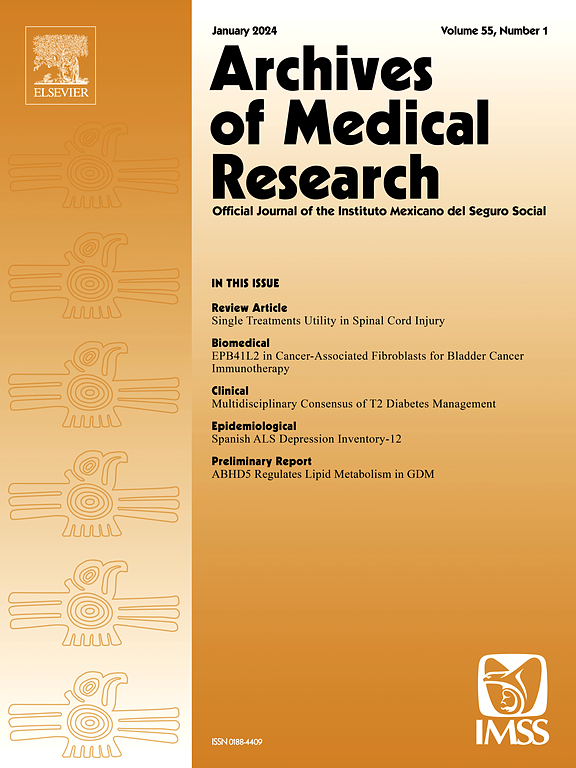功能性高风险多发性骨髓瘤移植患者的临床特征及预测模型
IF 3.4
3区 医学
Q1 MEDICINE, RESEARCH & EXPERIMENTAL
引用次数: 0
摘要
目的:一部分多发性骨髓瘤(MM)患者在诊断时没有任何高危特征,但早期复发,定义为预后不良的功能性高风险(FHR) MM。本研究比较了FHR和标准风险(SR) MM队列,以探讨临床危险因素,并建立一个有效的预后模型,用于早期预测MM移植患者FHR的发生。方法采用回顾性队列研究对MM患者的临床资料进行分析,通过单因素和多因素分析确定FHR-MM的独立危险因素。通过逻辑回归分析和内部验证开发了预后nomogram。结果研究队列包括357例MM患者。单因素和多因素分析确定以下为FHR-MM的独立预测因素:乳酸脱氢酶(LDH)≥190 U/L,基线时PET-CT SUVmax≥7.5,诱导后PET-CT SUVmax降低≥80%,血小板计数和lt 80×109/L,铁蛋白≥650µg/L, m蛋白B型下降,自体干细胞移植(ASCT)后达到完全缓解(CR)。导出的预测模型显示,训练集的曲线下面积(AUC)得分为0.753 (95% CI 0.666-0.840),验证集的AUC得分为0.857 (95% CI 0.759-0.954)。结论本研究建立了FHR-MM移植患者的预测nomogram,该nomogram通过内部验证显示了稳健的判别能力。本文章由计算机程序翻译,如有差异,请以英文原文为准。
Clinical Feature and Predictive Model for Transplanted Patients With Functional High-Risk Multiple Myeloma
Objective
A subset of patients with multiple myeloma (MM) experience early relapse despite the absence of any high-risk features at diagnosis, defined as functional high-risk (FHR) MM with inferior prognosis. This study compared FHR and standard risk (SR) MM cohorts to investigate clinical risk factors and establish a validated prognostic model for early prediction of FHR in patients with MM that were transplanted.
Methods
A retrospective cohort study was conducted to analyze the clinical data of patients with MM. Univariate and multivariate analyses were performed to identify independent risk factors for FHR-MM. A prognostic nomogram was developed through logistic regression analysis and internally validated.
Results
The study cohort comprised 357 MM patients. Univariate and multivariate analyses identified the following as independent predictors of FHR-MM: lactate dehydrogenase (LDH) ≥190 U/L, PET-CT SUVmax ≥7.5 at baseline, post-induction ≥80% reduction in PET-CT SUVmax, platelet count <80×109/L, ferritin ≥650 µg/L, Pattern B of M-protein decline, and achieved complete remission (CR) after autologous stem cell transplantation (ASCT). The derived predictive model demonstrated area under the curve (AUC) scores of 0.753 (95% CI 0.666–0.840) for the training set and 0.857 (95% CI 0.759–0.954) for the validation set.
Conclusion
This study established a predictive nomogram for transplanted patients with FHR-MM that demonstrates robust discriminative capacity through internal validation.
求助全文
通过发布文献求助,成功后即可免费获取论文全文。
去求助
来源期刊

Archives of Medical Research
医学-医学:研究与实验
CiteScore
12.50
自引率
0.00%
发文量
84
审稿时长
28 days
期刊介绍:
Archives of Medical Research serves as a platform for publishing original peer-reviewed medical research, aiming to bridge gaps created by medical specialization. The journal covers three main categories - biomedical, clinical, and epidemiological contributions, along with review articles and preliminary communications. With an international scope, it presents the study of diseases from diverse perspectives, offering the medical community original investigations ranging from molecular biology to clinical epidemiology in a single publication.
 求助内容:
求助内容: 应助结果提醒方式:
应助结果提醒方式:


